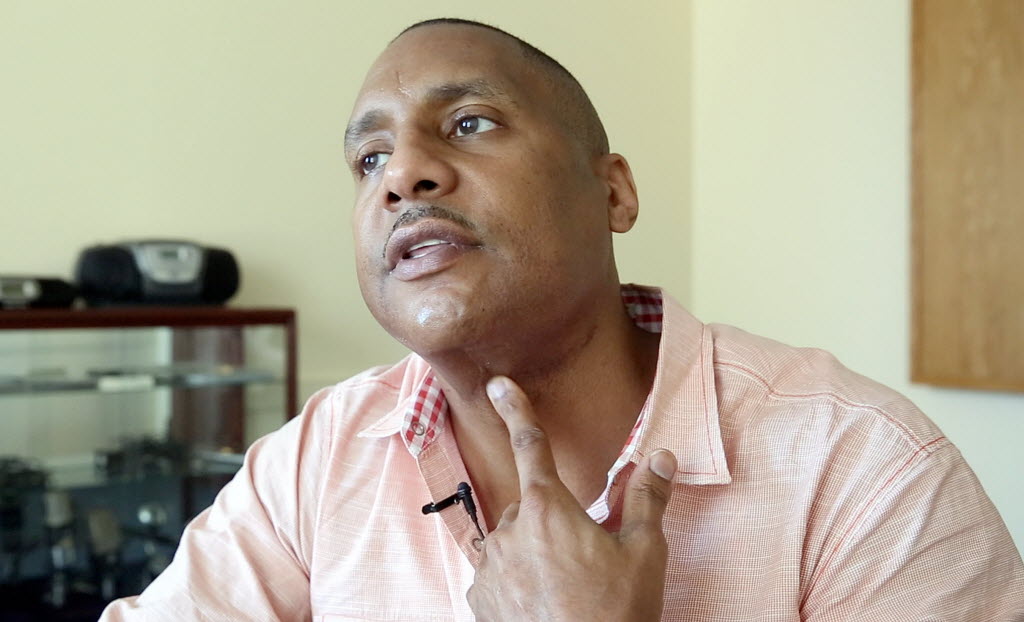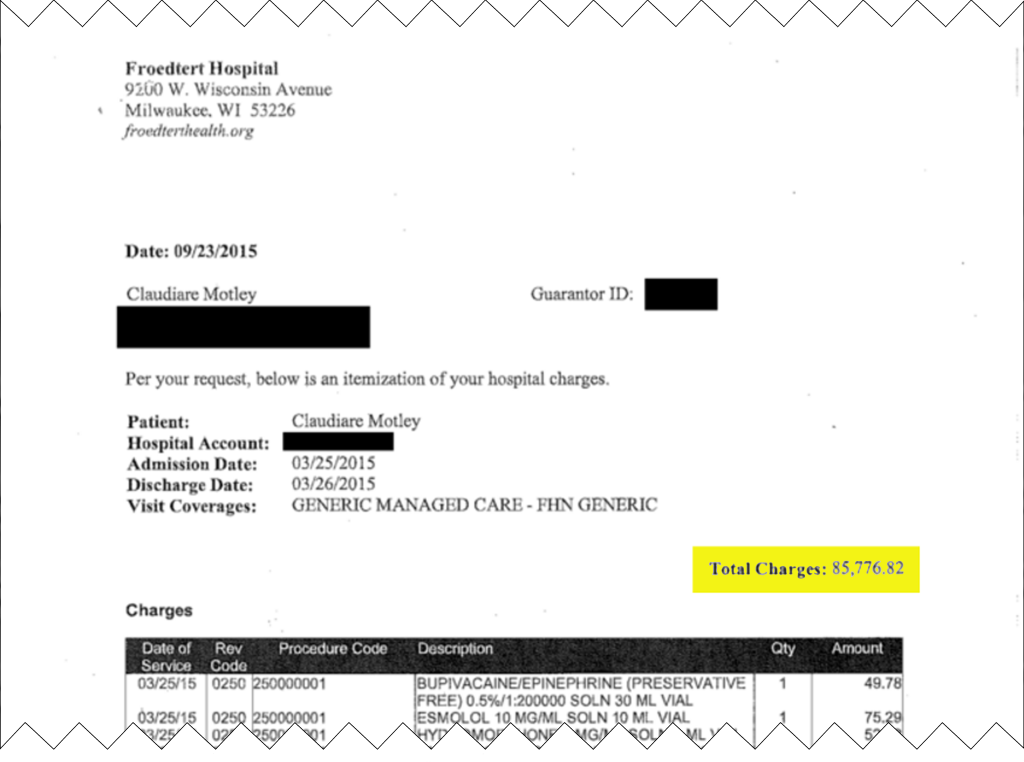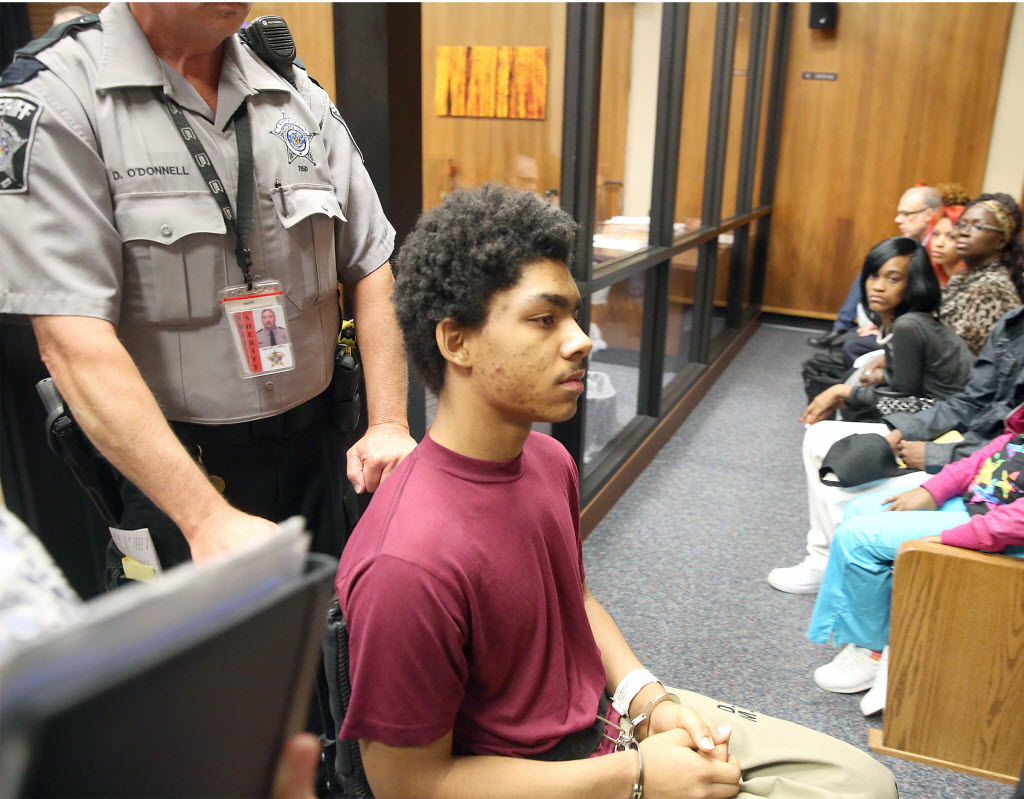The Soaring Cost of Gun Violence
Estimated annual cost in Wisconsin is $2.9 billion, or $508 per person.

Claudiare Motley still has scars on his neck after a teen shot him on June 21, 2014, during an attempted carjacking. Motley estimates the resulting medical bills, lost wages and travel costs for medical appointments and court hearings have cost him about $80,000 out-of-pocket. Motley is pictured here in downtown Milwaukee on Oct. 14. Photo by Mike De Sisti of the Milwaukee Journal Sentinel.
It was 1:30 a.m. on the first day of summer in 2014, and Claudiare Motley had just dropped off a friend after coming into town for his Milwaukee Tech High School 25-year class reunion. He was parked around North 63rd Street and West Capitol Drive, writing an email on his phone, as two cars pulled up.
Motley, then 43, knew “something was going on” as one of the vehicles turned in front of him and stopped. He put his phone into his pocket, shifted his car into gear. A teenager jumped from the car and tapped Motley’s window with a gun.
He accelerated as 15-year-old Nathan King fired, shattering glass. Motley rammed the car in front of him out of the way. He sped off and looked in the rearview mirror to see if they were chasing him.
“I just saw blood gushing out of my jaw,” Motley said.
After more than a year and six surgeries to repair his injuries, Motley estimates his out-of-pocket costs to be at least $80,000, and he expects more medical expenses as he continues to recover.
His efforts to get state victim’s compensation for his medical bills not covered by insurance have been unsuccessful so far. Motley’s credit has taken a hit, and he estimates lost earnings because of time he could not work in his family’s international law firm to be between $40,000 and $60,000.
Wisconsin taxpayers and health care providers also pay a high price for gun violence. In April, Mother Jones magazine pegged the cost of gun violence to Wisconsinites in 2012 at $2.9 billion in direct and indirect costs, or $508 for every person in the state.
Those figures include the financial and psychological tolls taken when a bullet forever alters the lives of victims and shooters alike. There are lost wages, stunted futures, shattered plans, life-changing trauma.

The credit of shooting victim Claudiare Motley has taken a hit after a 2014 shooting left him paying tens of thousands of dollars in out-of-pocket medical and other expenses. Photo by Haley Henschel of the Wisconsin Center for Investigative Journalism.
Firearms are a big factor in crime statewide. In 2014, guns were involved in 75 percent of murders, 56 percent of armed robberies, 27 percent of aggravated assaults and 3 percent of forcible rapes, according to the state Department of Justice.
Taxpayers pay all of the costs for police, prosecutors and incarceration — and sometimes to defend the accused — in gun crimes. And 79 percent of health care costs in Wisconsin associated with firearm-related injuries are paid by the public, according to a 2014 report using 2010 data by the Urban Institute, a Washington, D.C.-based think tank.
When he is released from prison, King — who is now paralyzed from the waist down because of a separate shooting days after he shot Motley — will probably face limited employment opportunities. Motley said he does not expect to see much of the $29,339 in court-ordered restitution.

Nathan King is wheeled out of court after being sentenced in July. King, who shot Claudiare Motley on June 21, 2014, was paralyzed from the waist down after being shot during another attempted robbery a few days later. Photo by John Klein for the Milwaukee Journal Sentinel.
State taxpayers paid about $1,500 for the 50 hours spent by Milwaukee County Assistant District Attorney Joy Hammond to prosecute King during the case that ended in September. They paid $1,537 for King’s attorney, Ann T. Bowe.
Residents of Wisconsin will spend about $405,000 to keep King in prison during his 12-and-a-half-year sentence for the Motley shooting and a later armed robbery in which King himself was shot. After he is released, King will be on extended supervision for seven and a half years at a cost to taxpayers of at least $21,000 in today’s dollars.
The tally for the Motley shooting — at least half a million dollars — is the cost of just one shooting in a city that this year has seen 691 people shot, including 131 killed, by firearms as of Nov. 15. That was a 77 percent increase in gun homicides from November 2014 and an 11 percent increase in nonfatal shootings.
Entire communities pay price
In addition to victims, entire communities face costs, including reduced property values in high-crime areas and increased costs to keep the public safe.
“It’s not just a problem for the individuals who are unlucky enough to get shot,” said Philip Cook, professor of public policy, economics and sociology at Duke University. “It’s a problem for whole communities. It’s a drag on economic development, it’s a drag on quality of life in a variety of ways.”
Violence was one of the things that prompted Motley to move out of his hometown of Milwaukee about eight years ago. He and his wife, Kimberley, and three children moved to Charlotte, North Carolina, in part to escape what he calls a “cultural acceptance of violence” and a “proliferation of guns and illegal drugs.”
“You always hear the bad things that could happen, but you never really think … that you actually encounter something like that,” he said.
A report from the Center for American Progress, a progressive public policy organization, suggests that a reduction in violent crime — including homicides, rapes and assaults — could have large impacts on urban areas. The report, which analyzed 2010 crime levels in Milwaukee and seven other cities, suggested a 10 percent reduction in homicides could boost residential real estate by $800 million in Milwaukee.
The report noted such a reduction could generate “large revenue gains” from property taxes, but it did not provide an estimate. Cutting homicides by 25 percent, it projected, could add $2 billion in increased housing values.

Police tape marks the scene where 13-year-old Giovonnie G. Cameron was shot and killed near Lincoln Park in Milwaukee on July 8. As of Nov. 15, fatal shootings in Milwaukee are up 77 percent compared to the same period in 2014. Photo by Mark Hoffman of the Milwaukee Journal Sentinel.
Experts say because the cost for each shooting is so high — often in the tens if not hundreds of thousands of dollars — anything that could reduce gun violence would likely be worth the investment.
“Almost any reasonable policy that reduces crime will pay for itself,” said David Weimer, a University of Wisconsin-Madison professor of political economy and expert in cost-benefit analysis.
But not everyone agrees on the best way to curb gun violence. Some have called for expanding background checks and for banning certain types of assault weapons.
Jeff Nass, executive director of Wisconsin Firearm Owners, Ranges, Clubs and Educators Inc., disagrees. He said any cost-benefit analysis should include the positive value that guns have when used for self-defense.
Nass, whose organization is affiliated with the National Rifle Association, argued that violence and gun issues are separate. He called for more prosecution of illegal gun possession and gun crimes.
“Bad violence is bad violence. Whether it’s done with a knife, a gun, whatever, it’s the person,” Nass said. “The people that we know are violent — that we know are in the criminal element — need to be held accountable.”
Article Continues - Pages: 1 2
-
Legislators Agree on Postpartum Medicaid Expansion
 Jan 22nd, 2025 by Hallie Claflin
Jan 22nd, 2025 by Hallie Claflin
-
Inferior Care Feared As Counties Privatize Nursing Homes
 Dec 15th, 2024 by Addie Costello
Dec 15th, 2024 by Addie Costello
-
Wisconsin Lacks Clear System for Tracking Police Caught Lying
 May 9th, 2024 by Jacob Resneck
May 9th, 2024 by Jacob Resneck




















It’s time to have a special sales tax on weapons and ammo to fund public safety and health care for victims. Also, the Supreme Court has refused to review a ban on assault weapons and high capacity magazines so it’s time to move forward on this front. Hunters are only allowed a certain amount of rounds in their weapons. They don’t need high capacity clips/magazines. AND the absurd notion that somehow or other “I” will ever need a high capacity magazine for protection needs to be challenged. Lastly, as a combat veteran of Vietnam (just a grunt) I wonder how many folks ever know how they will react when shot at? It’s a whole lot different than movies or macho strutting. It’s all about managing fear and learning how to do that. I would imagine even cops find themselves terrified in such situations and needing to learn. Let’s give up the notion that “the only thing that stops a bad guy with a gun is a good guy with a gun” as a reason for arming everybody. Note the situation in Neenah where the cops got it wrong, it seems, and shot a hostage who was a good guy with a gun? peace, tw
It’s ironic you you feel that way, tomw… because Nathan King, the boy who shot Claudiare, was eventually stopped by a ccw permit holder when King tried to rob her as well.
How about we hold parents accountable for their childrens actions… or at least for letting them run the streets at 1:30 am. Or how about we try to promote traditional family values and education. It’s no surprise that Nathan King came from a single parent household. Where are the fathers in all this?
How about we rescind this ludicrous no chase policy in Milwaukee? Nathan King and his crew stole car after car and used them in multiple violent crimes. By not chasing “non-violent” car thieves the criminals are free to use those stolen cars in many other crimes.
Motley is right, Milwaukee has a “cultural acceptance of violence” and a “proliferation of guns and illegal drugs.” We need families that support their children, improve enducation, and provide opportunities. Not create a tax on law abiding citizens who have no relationship to this violence.
And Ed Flynn says part of the gun problem is the state’s concealed carry law, but what does he know? He’s only the police chief.
I’m all for holding parents accountable. Too many times they aren’t charged when one of their guns is used in a shooting, accidental or otherwise, and that’s absurd.